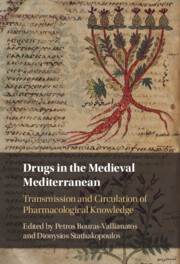Book contents
- Drugs in the Medieval Mediterranean
- Drugs in the Medieval Mediterranean
- Copyright page
- Contents
- Figures
- Tables
- Contributors
- Acknowledgements
- Note to the Reader
- Medieval Mediterranean Pharmacology
- Part I Transmission of Pharmacological Knowledge
- Chapter 1 Ibn al-Tilmīdh’s Book on Simple Drugs
- Chapter 2 Drugs, Provenance, and Efficacy in Early Medieval Latin Medical Recipes
- Chapter 3 De sexaginta animalibus
- Chapter 4 Arabic Terms in Byzantine Materia Medica
- Chapter 5 The Theriac of Medieval al-Shām
- Chapter 6 ‘Already Verified’
- Part II The Borders of Pharmacology
- Index
- References
Chapter 1 - Ibn al-Tilmīdh’s Book on Simple Drugs
A Christian Physician from Baghdad on the Arabic, Greek, Syriac, and Persian Nomenclature of Plants and Minerals
from Part I - Transmission of Pharmacological Knowledge
Published online by Cambridge University Press: 19 October 2023
- Drugs in the Medieval Mediterranean
- Drugs in the Medieval Mediterranean
- Copyright page
- Contents
- Figures
- Tables
- Contributors
- Acknowledgements
- Note to the Reader
- Medieval Mediterranean Pharmacology
- Part I Transmission of Pharmacological Knowledge
- Chapter 1 Ibn al-Tilmīdh’s Book on Simple Drugs
- Chapter 2 Drugs, Provenance, and Efficacy in Early Medieval Latin Medical Recipes
- Chapter 3 De sexaginta animalibus
- Chapter 4 Arabic Terms in Byzantine Materia Medica
- Chapter 5 The Theriac of Medieval al-Shām
- Chapter 6 ‘Already Verified’
- Part II The Borders of Pharmacology
- Index
- References
Summary
Amīn al-Dawla Ibn al-Tilmīdh (d. 1165) was born in Baghdad into a family of Christian physicians. He served several Abbasid caliphs, who entrusted him with high-ranking positions, such as that of ‘head of physicians’ of his hometown. He wrote about twenty books and treatises, including a renowned dispensatory. In this chapter I examine Ibn al-Tilmīdh’s little-known work on simple drugs, the Kitāb quwā l-adwiyah (Book on the Faculties of Simple Drugs). The text consists of 287 entries on medicinal plants, minerals, and a few animal products. Each entry is divided into five sections, dedicated respectively to synonyms, descriptions, ‘faculties’, benefits of the simple drug, and its use in compound remedies. The most interesting of these sections is the first, as Ibn al-Tilmīdh not only gave the usual Arabic names of plants and minerals and their synonyms there, but also regularly listed the Syriac, Persian, and Greek names of the drugs.
Keywords
- Type
- Chapter
- Information
- Drugs in the Medieval MediterraneanTransmission and Circulation of Pharmacological Knowledge, pp. 37 - 57Publisher: Cambridge University PressPrint publication year: 2023

